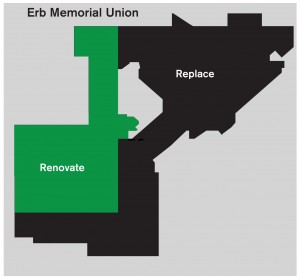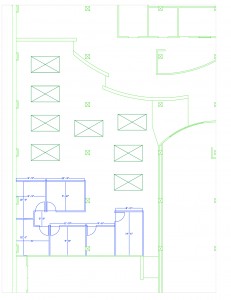
|
|
Archive for the 'EMU' Category
May 8th, 2011 by Lyzi Diamond

Friday’s RG had an interesting Greg Bolt article about the upcoming EMU and Student Rec Center renovations. The Oregon Commentator has covered this issue sporadically throughout the year, but Mr. Bolt has more information on how the project is moving forward, and how it is going to be funded [emphasis added]:
The University of Oregon could soon launch a huge overhaul of student recreation and activities facilities if it can win quick state approval of a $160.5 million plan to expand two key buildings.
The plan, which faces some challenges, would demolish and rebuild a substantial portion of the Erb Memorial Union, the central gathering space on campus for students and student groups. It also would add more than 100,000 square feet to the Student Recreation Center, including adding a two-pool swimming center.
Money for the project — which would get under way next year if approved by the state university system and legislators — would come from several sources, including private donations and funds already set aside for the work. But the largest amount would be raised through bonds backed by a substantial new fee on students, including students who would graduate before ever getting to use the new buildings.
For comparison, the most recent renovations to the Student Recreation Center happened in 1997, and current students are still paying them off, to the tune of $43.25 per term. This fee has been flat since Fall 2009, but was rising before it reached that plateau. It seems that the new fees will have a similar structure:
The work would be financed using $13.5 million the university previously set aside for the project, $35 million in private donations and the rest through bonds repaid with the new student fee. The fee would start at $30 per term in 2011-12, rise to $60 per term in 2012-13 and after that would remain at $100 per term — that’s $300 for an academic year — until the bonds were repaid.
$100 per term? Tack on the aforementioned $43.25 for the 1997 Rec Center renovations, the $45 building fee (for students taking 9 credits or more), $140.75 for the health services fee (regardless of how many credits you’re taking), and the $191 incidental fee, and you’re looking at $520 in fees per term (at least — we all know the incidental fee is going to keep rising no matter what). That’s $1,560 per year in fees, on top of tuition. That’s insane.
Now, the bonds and the subsequent student fee will still have to be approved by the state legislature, and never before has the legislature approved a fee for a building before it was built (for obvious reasons). Leave it to the University of Oregon to try and rock that boat.
What will we be getting for this exorbitant cost to students?
The newer wing of the EMU, built in the 1970s, would be demolished and rebuilt, creating 107,000 square feet of new construction.
With renovation of the older, Ellis Lawrence-designed main building, the EMU would gain a 1,200-seat performance venue, conference facilities, a 300-seat theater, expanded food court, space for 15 student unions and scores of student organizations, a computer lab and other features.
The original plan also included underground parking, but that was eliminated to save money.
[…]
The Student Recreation Center would gain a swimming center with connected lap and leisure pools, double the space for weight and fitness equipment, a three-court gym, expanded indoor jogging track, new racquetball and squash courts, new outdoor synthetic turf fields and more.
I completely understand the reason for the renovation, especially to the EMU, which is to bring more students to their student union. The biggest problem with the union, however, and any EMU board member will tell you this, is that the building is not financially self-sufficient. There are not enough revenue-generating services in the building to sustain itself, so students are subsidizing the cost of the building to the tune of $5,091,532 for 2011-12 (that’s for programs, services and building operations), plus additional funds from elsewhere in the university.
I have yet to see the official renovation plans, so I am unsure as to what exactly the new EMU will entail, but one worthy upgrade would be an actual kitchen (the one currently being used by food services is makeshift). Ideally, the performance venue and theater will create some revenue generation, or at least bring students to the union to make it a central part of campus. (Side note: did you know that the Grateful Dead once played in the EMU Ballroom, as well as many other worthwhile acts including Mudhoney?)
But the elimination of parking was also an interesting choice. And the (in my opinion, ridiculously extravagant) upgrades to the Student Rec Center seem frivolous and unnecessary, especially considering the state of disrepair of many other campus buildings.
Another issue that has not been addressed here is the fact that, from what I’ve heard, student programs will no longer have individual offices once the building is renovated. When I spoke with Vice President of Capital Projects Gregg Lobisser this past fall, he mentioned that the “space for 15 student unions and scores of student organizations” mentioned in the article would mean 15 satellites for student groups, including the Student Sustainability Center, the Multicultural Center, the ASUO and the Women’s Center. Within these satellite spaces, individual student programs would have their own work stations with lockers, but would likely not have their own office spaces.
Additionally, when we spoke, he said there were not yet plans for accommodation of student media services — that is to say, none of these “satellite unions” will be a Student Media Center, or even anything remotely similar.
Granted, the current model does not adequately serve the hundreds of groups that a student union should be able to accomodate. There are over 160 fee-funded student programs and less than half of them have offices, but those who do have offices have had them for a long time and use them to the fullest. Ask a program like the Oregon Voice, who was displaced from its office earlier this year to a much smaller space in The Break. Noah Dewitt, editor-in-chief of the Oregon Voice, said that the new space is much smaller than the previous space, does not have any storage space, is much louder than their previous space (The Break has a multitude of pool and ping-pong tables), and is open subject to The Break’s operating hours rather than the EMU’s operating hours, which means they can’t access their space as frequently. The storage space is likely the biggest issue, because they can’t access their archives themselves — they need someone from EMU Facilities to let them into their own storage.
Some student groups, the Oregon Commentator included, use their spaces for myriad activities — in our example, we hold meetings and work sessions in our office, as well as producing our magazine. I can’t imagine how difficult it would be to undergo production with a Student Insurgent desk five feet away and a Siren workstation five feet behind. It would be near impossible to do what we do under these circumstances.
Again, this all has yet to be approved by the legislature, and frankly, I’m not sure it will. But it’s something to start thinking about now, during the planning stages when large decisions are being made.
The rumor mill says that most members of the EMU Board have signed a letter in support of this student fee. That makes sense — most of them won’t be around when the fee is incurred, so it won’t affect them. But it’s sure as shit going to affect most students on this campus, most of whom will never see the finished products.
Student fees are rising constantly, tuition is skyrocketing out of control, and to charge students who will no longer be around to experience the new buildings is asinine, especially for a building that is going to devalue the experience of being involved in student organizations. Maybe a new EMU theater and a Rec Center swimming pool are going to be awesome, but at the cost to students, it seems like an unworthy investment.
Posted in ASUO, Campus, EMU, Fiscal Responsibility, Oregon, Politics, Stupid, University | 3 Comments »
April 19th, 2011 by Ben Maras
Ever yearn for the days of elementary school, when all it took to be cool and edgy was to dare to step foot into the bathroom of the opposite sex? Well your dreams are about to be answered. Tomorrow, in celebration of Trans Week of Celebration and Disability Awareness Week, and coincidentally on 4:20 / Joey Lawrence’s birthday, the women’s restroom on the ground floor of the EMU will be open to people of any sex and /or gender, from 9 a.m. to 5 p.m. Your ASUO representatives, along with members of Oregon Student Equal Rights Alliance and the LGBTQA, will be on site to welcome the tired, weary and huddled masses and promote gender issues as part of the “Be Free to Pee” event.
“There are many UO students who identify as trans, or who don’t identify with the male or female gender,” said ASUO Accessibility Advocate Kai Kubitz. “Many people don’t fit in the gender binary. We want to educate students that there are many genders.”
There are already a couple of gender-inclusive restrooms on campus, such as in the law school, Lawrence Hall and that corner of the Oregon Commentator office that smells kinda funny — but organizers hope that the event will pave the way for more officially-sanctioned genderless restrooms in the soon-to-be-remodeled EMU and Rec Center.
“Gendered restrooms are inherently discriminatory. Gender inclusive restrooms allow people to access the restroom without forcing students to make a statement about what gender they identify as,” said ASUO Gender and Sexual Diversity Kelsey Jarone.
The only real question we have is: Will the seat be left up, or down, when not in use?
Posted in ASUO, Campus, Civil Liberties, EMU, Miscellaneous, Sex | 17 Comments »
February 17th, 2011 by Ben Maras

The University of Oregon may ban the sale of bottled water on campus, due to its environmental effects, a growing trend on campuses nationwide.
The movement is part of a national campaign called “Take Back the Tap,” which was adopted and promoted by the Climate Justice League, a superhero cape-wearing environment-advocating student group at the U of O.
“Bottled water is not necessary because we already have perfectly good tap water, and it’s terrible for the environment. It’s better just to get it out of our economy, and out of our ecosystems,” said freshman Manny Garcia, co-coordinator of UO’s Take Back the Tap.
“If you were to take, in 2009, all the bottled water, and you stacked them on top of each other, you would go to the moon and back 65 times,” he said, adding that only 5 percent of those are recycled worldwide.
The Associated Students of the University of Oregon has voted to support Take Back the Tap’s proposal to ban the sale of bottled water; the proposal was passed 12-3-1.
There is no official data yet on how many bottles are sold on campus. Officials have collected data on the dining halls, but do not yet have figures from the food vendors in the student union or the athletics department, which they expect to be a substantial percentage of the total.
(more…)
Posted in ASUO, Campus, EMU, Miscellaneous, National, Oregon | 4 Comments »
November 14th, 2010 by Lyzi Diamond
During its meeting on October 27th, the EMU Board approved a proposal that will accommodate a Student Sustainability Center in the EMU by undergoing minor shifts in student space. These shifts will occur in the next few months, with the permitting process beginning this week.
The approved proposal includes three main shifts: the six groups currently housed in Suite 20 will move into office-type accommodations in The Break; the Service Learning Program will move into Suite 20; and the new Student Sustainability Center will move into the space that currently houses the Service Learning Program.
The accommodations for Suite 20 groups in The Break will include individual offices with nine-foot temporary walls and locking doors.
The vision for a Student Sustainability Center existed long before this year, but increased momentum and wider student involvement have allowed the project to reach this point. Most specifically, this includes the creation of a Student Sustainability Coalition, where 15 university groups with mission statements surrounding sustainability can work together on issues that affect them.
(more…)
Posted in ASUO, Campus, EMU, University | 3 Comments »
November 1st, 2010 by Kellie B.
According to various news sources, the post office in the EMU will be shut down effective December 31st. This is going to be a large problem for international students, freshmen, students with disabilities for whom travel is no small task, students with no wheeled transport, and busy people in general.
Will there be a protest? Will there be an outcry? Unlikely, as no one at UO enjoys protesting things that have an actual impact on student’s day-to-day lives. Did the Phil Knight just gift the University a 41.7 million dollar moated glass brick in order for athletes to more effectively copy their homework? Yes. But, lets be real, no one really gives a shit about anything but sports at this school, so why would they spend on anything else?
A map with directions to the University’s new post office location will be posted whenever we can figure out where exactly the “Southside Station” is.
Posted in Campus, EMU, Fiscal Responsibility, Miscellaneous, Stupid | 3 Comments »
October 27th, 2010 by Lyzi Diamond
The EMU Board today decided on some EMU space moving and renovations (NOT related to SAFAC or the new EMU*). They are:
1. The Service Learning Program is moving into Suite 20, which currently houses the Oregon Voice, the College Republicans, the Hawaii Club, UO Ballroom Dance, Pit Crew and Alpha Phi Omega. This moves the SLP next to the Holden Leadership Center, of which it is now a subsidiary.
2. The new Sustainability Center, where the Student Sustainability Coordinator and the 15 environmental student groups will be housed, will move into SLP’s space under the breezeway across from the Union Market.
3. The Break (on the other side of the Holden Leadership Center) will now be a hybrid space, housing the groups from Suite 20 as well as the amenities the Break has currently (pool tables, table tennis, more). The office space would not include full walls, but the walls would be about 9ft with locking doors and individual spaces for each program.
I’ll have more once I interview Kaitlyn Lange, EMU Board Chair, once this meeting is over.
*Speaking of the new EMU, there’s a new survey out regarding student space. If you are a UO student, you got it in your email. It closes November 8. PLEASE fill it out to make sure that the new EMU has what you want in it, or what you wish this EMU could have now.
UPDATE
This is the approved floor plan for the Break:

Posted in ASUO, EMU | Comments Off on Shifting EMU Space [UPDATED]
October 14th, 2010 by Lyzi Diamond
So I’ve been holding off on writing about the new EMU, cos I can’t seem to get anybody on the record explicitly about it (yet). I can write about one thing, though, because it has been discussed in public meetings: student group spaces.
Currently, many ASUO fee-funded programs have their own offices, including the Oregon Commentator, the Black Student Union, the Designated Driver Shuttle, etc. Every plan I’ve seen for the new EMU includes collaborative student spaces: complete with a desk, a computer, and a locker for personal affects. Basically, student groups will be placed in cubicles, with big desks and collaborative spaces that any student can use.
This distinct lack of student group space presents a problem at very least for us — we need our full office to produce a magazine. Every week we are in the office, working away all day trying to get the issue edited and laid out. We print over and over again, we put the pages on the ground to look at. Without this space, our issues would look a lot less sharp than they do (and they’re not terribly sharp to begin with, so just imagine the horror).
Even outside of the Commentator, other student groups utilize the shit out of their spaces. As a former Designated Driver Shuttle employee, I can tell you that a collaborative space in that environment would be detrimental to the program. I can only imagine that many other student groups would agree.
I understand that the EMU as it stands currently does not provide many spaces for students not in student groups (see: most students). That is definitely a problem, as the student union is supposed to serve all students. But a good friend of mine pointed out to me yesterday that the output of student programs often serves to benefit the lives of the rest of the student population. In the case of most programs, I would say that this is fairly true. Assault Prevention Shuttle, for one. Child Care Subsidy for another. Will a lack of a distinct office hinder the ability of these programs to do their jobs? Maybe, maybe not. That remains to be seen.
I’ve been saying for a while that the fight for student group space in the new EMU is going to be horrendous. But it’s going to be a lot worse if there isn’t even any student group space to fight for.
Posted in ASUO, Campus, EMU | 1 Comment »
|




